

Construction trailers are mobile structures (trailers) used to accommodate temporary offices, dining facilities and storage of building materials during construction projects.


Construction trailers are mobile structures (trailers) used to accommodate temporary offices, dining facilities and storage of building materials during construction projects.
Typically, trailers need to be equipped with telephone lines and electrical power. Lavatories are usually provided for separately. They are often skid-mounted, on trailers, or put on piles. Construction trailers are often manufactured using traditional stick-frame construction. Intermodal containers are also being converted into construction trailers.
Municipalities can require the use of construction trailers to be subject to permit proceedings. The City of Fremont, California, for example, publishes its permit requirements on its municipal website. [1] Enclosed Cargo Trailers are a very popular tool used by many in the construction industry. Keeping equipment and materials clean and dry are a high priority to anyone in the construction industry. These trailers are very user friendly and are multipurpose. Hauling generators, ladders, air compressors and other small to medium sized power tools from one job site to the next is a necessity. Construction trailers are ordinarily moved by heavy trucks but may also be moved by rail.

There are people in Europe, especially in German-speaking Europe, who live in trailers of this type, and in German there are words for a congregation of these trailers, Bauwagenplatz and Wagenburg. These trailers, usually lacking modern-day comforts like heating, electricity, toilets and running water, have become a popular form of eco-friendly alternative lifestyle among people mainly from hippie, punk and environmentalist subcultures. [2] The scene bears similarities and can be seen as a European counterpart to housetruckers and the Tiny-house movement.
In 2008 Norwegian media reported that two construction sites (of Byggmester Harald Langemyhr AS) had been housing Polish workers in construction trailers — 4 workers in each. [3]
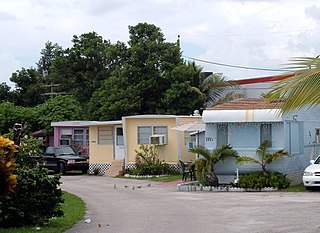
A trailer park, caravan park, mobile home park, mobile home community or manufactured home community is a temporary or permanent area for mobile homes and travel trailers. Advantages include low cost compared to other housing, and quick and easy moving to a new area.

An electrician is a tradesperson specializing in electrical wiring of buildings, transmission lines, stationary machines, and related equipment. Electricians may be employed in the installation of new electrical components or the maintenance and repair of existing electrical infrastructure. Electricians may also specialize in wiring ships, airplanes, and other mobile platforms, as well as data and cable lines.

A recreational vehicle, often abbreviated as RV, is a motor vehicle or trailer that includes living quarters designed for accommodation. Types of RVs include motorhomes, campervans, coaches, caravans, fifth-wheel trailers, popup campers, and truck campers.

A crane is a type of machine, generally equipped with a hoist rope, wire ropes or chains, and sheaves, that can be used both to lift and lower materials and to move them horizontally. It is mainly used for lifting heavy objects and transporting them to other places. The device uses one or more simple machines to create mechanical advantage and thus move loads beyond the normal capability of a human. Cranes are commonly employed in transportation for the loading and unloading of freight, in construction for the movement of materials, and in manufacturing for the assembling of heavy equipment.

A caravan, travel trailer, camper, tourer or camper trailer is a trailer towed behind a road vehicle to provide a place to sleep which is more comfortable and protected than a tent. It provides the means for people to have their own home on a journey or a vacation, without relying on a motel or hotel, and enables them to stay in places where none is available. However, in some countries campers are restricted to designated sites for which fees are payable.

Heavy equipment, heavy machinery, earthmovers, construction vehicles, or construction equipment, refers to heavy-duty vehicles specially designed to execute construction tasks, most frequently involving earthwork operations or other large construction tasks. Heavy equipment usually comprises five equipment systems: the implement, traction, structure, power train, and control/information.
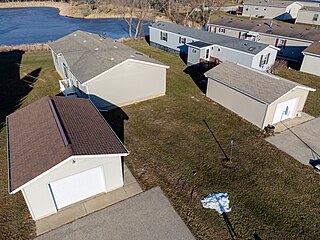
A mobile home is a prefabricated structure, built in a factory on a permanently attached chassis before being transported to site. Used as permanent homes, or for holiday or temporary accommodation, they are often left permanently or semi-permanently in one place, but can be moved, and may be required to move from time to time for legal reasons.

A modular building is a prefabricated building that consists of repeated sections called modules. Modularity involves constructing sections away from the building site, then delivering them to the intended site. Installation of the prefabricated sections is completed on site. Prefabricated sections are sometimes placed using a crane. The modules can be placed side-by-side, end-to-end, or stacked, allowing for a variety of configurations and styles. After placement, the modules are joined together using inter-module connections, also known as inter-connections. The inter-connections tie the individual modules together to form the overall building structure.

A log cabin is a small log house, especially a less finished or less architecturally sophisticated structure. Log cabins have an ancient history in Europe, and in America are often associated with first-generation home building by settlers.
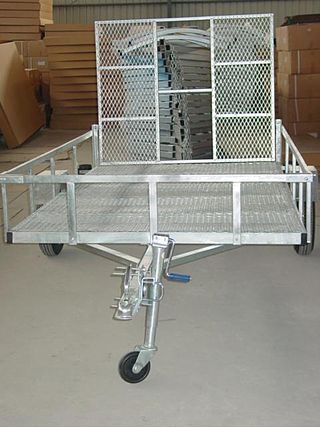
A trailer is an unpowered vehicle towed by a powered vehicle. It is commonly used for the transport of goods and materials.
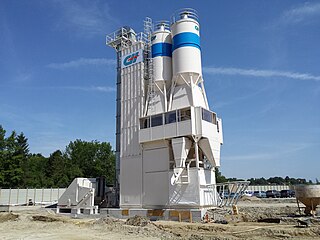
A concrete mixer is a device that homogeneously combines cement, aggregate, and water to form concrete. A typical concrete mixer uses a revolving drum to mix the components. For smaller volume works, portable concrete mixers are often used so that the concrete can be made at the construction site, giving the workers ample time to use the concrete before it hardens. An alternative to a machine is mixing concrete by hand. This is usually done in a wheelbarrow; however, several companies have recently begun to sell modified tarps for this purpose.
A general contractor, main contractor, prime contractor, builder (UK/AUS), or contractor is responsible for the day-to-day oversight of a construction site, management of vendors and trades, and the communication of information to all involved parties throughout the course of a building project. In the USA a builder may be a sole proprietor managing a project and performing labor or carpentry work, have a small staff, or may be a very large company managing billion dollar projects. Some builders build new homes, some are remodelers, some are developers.
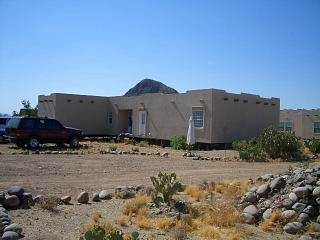
Manufactured housing is a type of prefabricated housing that is largely assembled in factories and then transported to sites of use. The definition of the term in the United States is regulated by federal law : "Manufactured homes are built as dwelling units of at least 320 square feet (30 m2) in size with a permanent chassis to assure the initial and continued transportability of the home." The requirement to have a wheeled chassis permanently attached differentiates "manufactured housing" from other types of prefabricated homes, such as modular homes.

Shipping container architecture is a form of architecture that uses steel intermodal containers as the main structural element. It is also referred to as cargotecture or arkitainer, portmanteau words formed from "cargo" and "architecture". This form of architecture is often associated with the tiny-house movement as well as the sustainable living movement.

Construction waste or debris is any kind of debris from the construction process. Different government agencies have clear definitions. For example, the United States Environmental Protection Agency EPA defines construction and demolition materials as “debris generated during the construction, renovation and demolition of buildings, roads, and bridges.” Additionally, the EPA has categorized Construction and Demolition (C&D) waste into three categories: non-dangerous, hazardous, and semi-hazardous.

Housetruckers are individuals, families and groups who convert old trucks and school buses into portable homes called housetrucks and live in them, preferring an unattached and transient lifestyle to more conventional housing. These vehicles began appearing around New Zealand during the mid-1970s and, even though there are fewer today, they continue to travel New Zealand roads.

The tiny-house movement is an architectural and social movement that advocates for the downsizing and simplification of living spaces. According to the 2018 International Residential Code, Appendix Q Tiny Houses, a tiny house is classified as "a dwelling unit with a maximum of 37 square metres of floor area, excluding lofts." The term "tiny house" is sometimes used interchangeably with "micro-house". While tiny housing primarily represents cheap, simple living, the movement also advertises itself as a potential eco-friendly solution to the existing housing industry, as well as a transitional option for the currently homeless.

Van-dwelling or vanlife is an unconventional lifestyle of living in a car, van or other motor vehicle. A person who lives in such a manner, either on a full or part-time basis, is known as a van dweller, car dweller or vehicle dweller. People who live this way by choice are typically seeking a more self-sufficient lifestyle characterized by freedom and mobility. They may perceive it as being a less regulated form of housing, or one that offers a lower cost advantage over standard housing, especially in regions susceptible to housing shortages. Other van dwellers may be one step away from living on the street or in a shelter.

Demolition is the science and engineering in safely and efficiently tearing down of buildings and other artificial structures. Demolition contrasts with deconstruction, which involves taking a building apart while carefully preserving valuable elements for reuse purposes.
Alternative housing is a category of domicile structures that are built or designed outside of the mainstream norm e.g., town homes, single family homes and apartment complexes. In modern days, alternative housing commonly takes the form of tiny houses, dome homes, pyramid-shaped houses, earth sheltered homes, residential tree houses, abandoned factories and hospitals and even up-cycled vans or buses. The motivation to create alternative homes can arise from destitution or lack of resources to buy or rent a typical home and therefore include improvised shacks in shantytowns, buses, cars and tent-like structures.